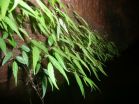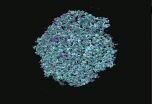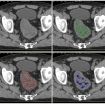Bizarre mapping error puts newly discovered species in jeopardy
New species, named after the Luama Katanga Reserve, is now threatened by cattle ranches and forest destruction
2014-11-11
(Press-News.org) Reserve's borders have erroneously moved 50 kilometers
New species, named after the Luama Katanga Reserve, is now threatened by cattle ranches and forest destruction
NEW YORK (November 11, 2014) - WCS scientists in the Democratic Republic of Congo (DRC) have discovered a new species of plant living in a remote rift valley escarpment that's supposed to be inside of a protected area. But an administrative mapping error puts the reserve's borders some 50 kilometers west of the actual location. Now the new species, along with 900 other plant varieties and 1,400 chimpanzees, are in limbo with no protection and threatened by cattle ranches and forest destruction.
This astounding announcement was made at the 2014 IUCN World Parks Congress in Sydney, Australia - a once-in-a-decade global forum on protected areas.
The newly discovered flowering plant species Dorstenia luamensis is supposed to be named for its home - the Luama Katanga Reserve, a protected area established in 1947 near Lake Tanganyika. But during DRC's civil wars, administrators in the government and the World Conservation Monitoring Center have confused the reserve's location, placing it on maps far from its true location.
"The moral of this story is that keeping track of parks - and especially getting maps and boundaries correct - matters hugely for biodiversity. The call to action here is to fix the records and re-protect the reserve before this unique plant and all the biodiversity it contains, including 1,400 chimpanzees, are destroyed," said James Deutsch, WCS Vice President of Conservation Strategy.
WCS scientists discovering the new plant species say it is restricted to just a few cliff faces found inside of the former protected area. It was described in the current issue of the journal PhytoKeys by WCS scientist Miguel Leal.
The true location of the reserve was adjacent to a globally important biodiversity hotspot called Kabobo, which is proposed as a new protected area (NGAMIKKA). This makes it even more important that the proper, old reserve be reinstated in order to safeguard the conservation landscape and the corridors between the two.
Said Andrew Plumptre, WCS Director of the Albertine Rift Program: "There is a real need to re-gazette the correct reserve as it is biologically important, and also because people are starting to move into it and cultivate it and graze cattle there. The reserve this plant was named after no longer exists because of an error from both WCMC and the government not checking their maps correctly."
INFORMATION:
Wildlife Conservation Society (WCS)
MISSION: WCS saves wildlife and wild places worldwide through science, conservation action, education, and inspiring people to value nature. VISION: WCS envisions a world where wildlife thrives in healthy lands and seas, valued by societies that embrace and benefit from the diversity and integrity of life on earth. To achieve our mission, WCS, based at the Bronx Zoo, harnesses the power of its Global Conservation Program in more than 60 nations and in all the world's oceans and its five wildlife parks in New York City, visited by 4 million people annually. WCS combines its expertise in the field, zoos, and aquarium to achieve its conservation mission. Visit: http://www.wcs.org; http://www.facebook.com/TheWCS; http://www.youtube.com/user/WCSMedia Follow: @thewcs.
CONTACT: STEPHEN SAUTNER: (1-718-220-3682; ssautner@wcs.org
JOHN DELANEY: (1-718-220-3275; jdelaney@wcs.org)
[Attachments] See images for this press release:

ELSE PRESS RELEASES FROM THIS DATE:
2014-11-11
For their study, the researchers were able to fall back on uninterrupted long-term temperature measurements of groundwater flows around the cities of Cologne and Karlsruhe, where the operators of the local waterworks have been measuring the temperature of the groundwater, which is largely uninfluenced by humans, for forty years. This is unique and a rare commodity for the researchers. "For us, the data was a godsend," stresses Peter Bayer, a senior assistant at ETH Zurich's Geological Institute. Even with some intensive research, they would not have been able to find a ...
2014-11-11
Many businesses now offer customers the opportunity to make charitable donations to good causes along with their purchases, but does this really encourage the customer to buy more? According to a new study in the Journal of Marketing, the answer is a firm "Yes."
"The mere presence of a charitable donation opportunity can generate significantly more sales," write authors Michelle Andrews (Temple University), Xueming Luo (Temple University), Zheng Fang (Sichuan University) and Jaakko Aspara (Hanken Swedish School of Economics). "Offering the donation nearly doubled the ...
2014-11-11
When consumers see a company performing good deeds, they often assume that the company's products are healthy. According to a new study in the Journal of Public Policy & Marketing this may be far from true, and the company's socially responsible behavior may be creating a "health halo" over unhealthy foods.
"Research demonstrates that consumers frequently engage in inference making when evaluating food products. These inferences can be highly inaccurate, leading to unintended, unhealthy consumer choices," write authors John Peloza (University of Kentucky), Christine Ye ...
2014-11-11
A novel method of altering a protein in milk to bind with an antiretroviral drug promises to greatly improve treatment for infants and young children suffering from HIV/AIDS, according to a researcher in Penn State's College of Agricultural Sciences.
That's critical because an estimated 3.4 million children are living with HIV/AIDS, the World Health Organization reports, and nine out of 10 of them live in resource-limited countries in sub-Saharan Africa, where effective antiretroviral treatments still are not widely accessible or available. International medical experts ...
2014-11-11
Enterotoxigenic Escherichia coli (ETEC) bacteria are responsible each year for around 400 million cases of diarrhoea and 400,000 deaths in the world's low- and middle-income countries. Children under the age of five are most affected.
ETEC bacteria also cause diarrhoea in nearly one in two travellers to these areas.
Major breakthrough
Researchers at the University of Gothenburg's Sahlgrenska Academy are world leaders in research into ETEC and have now made a major breakthrough in collaboration with colleagues from the Wellcome Trust Sanger Institute in the UK, Karolinska ...
2014-11-11
As football players are learning, a violent blow to the head has the potential to cause mild to severe traumatic brain injury -- physical damage to the brain that can be debilitating, even fatal. The long-term effects run the gamut of human functioning, from trouble communicating to extensive cognitive and behavioral deterioration. To date, there is no effective medical or cognitive treatment for patients with traumatic brain injuries.
But a new study from Tel Aviv University researchers points to an "enriched environment" -- specially enhanced surroundings -- as a promising ...
2014-11-11
Technology developed at the University of Sussex helps hospitals make earlier and more accurate treatment decisions and survival assessments for patients with bowel cancer.
Bowel cancer kills more than 16,000 people a year in the UK, making it the nation's second-most common cause of cancer death (after lung cancer).
A novel medical-imaging technology, TexRAD, which analyses the texture of tumours, has been shown in trials to enable early diagnosis of those bowel-cancer patients not responding to the standard cancer therapy better than other available tumour markers. ...
2014-11-11
Changes to China's drink driving laws are catching the community off guard with more than 70 per cent of people unaware of the blood alcohol limits that could see them face criminal charges, according to new Queensland University of Technology (QUT) research conducted in two Chinese cities.
QUT's Centre for Accident Research & Road Safety - Queensland (CARRS-Q) has partnered with organisations in China to promote road safety and reduce fatalities and injuries, as alcohol-related driving offences are being brought into sharper focus because of the country's rapid motorisation ...
2014-11-11
A new climate change modeling tool developed by scientists at Indiana University, Princeton University and the National Oceanographic and Atmospheric Administration finds that carbon dioxide removal from the atmosphere owing to greater plant growth from rising CO2 levels will be partially offset by changes in the activity of soil microbes that derive their energy from plant root growth.
Soils hold more carbon than all of the earth's plant biomass and atmosphere combined. The new work published by Benjamin N. Sulman, a postdoctoral researcher in the lab of co-author and ...
2014-11-11
INDIANAPOLIS -- A new treatment regimen for hepatitis C, the most common cause of liver cancer and transplantation, has produced results that will transform treatment protocols for transplant patients, according to research published online today in the New England Journal of Medicine.
The investigational three-drug regimen, which produced hepatitis C cure rates of 97 percent, is an oral interferon-free therapy. Previously, the typical treatment for hepatitis C after a liver transplant was an interferon-based therapy, usually given for 48 weeks. It had a much lower response ...
LAST 30 PRESS RELEASES:
[Press-News.org] Bizarre mapping error puts newly discovered species in jeopardy
New species, named after the Luama Katanga Reserve, is now threatened by cattle ranches and forest destruction





